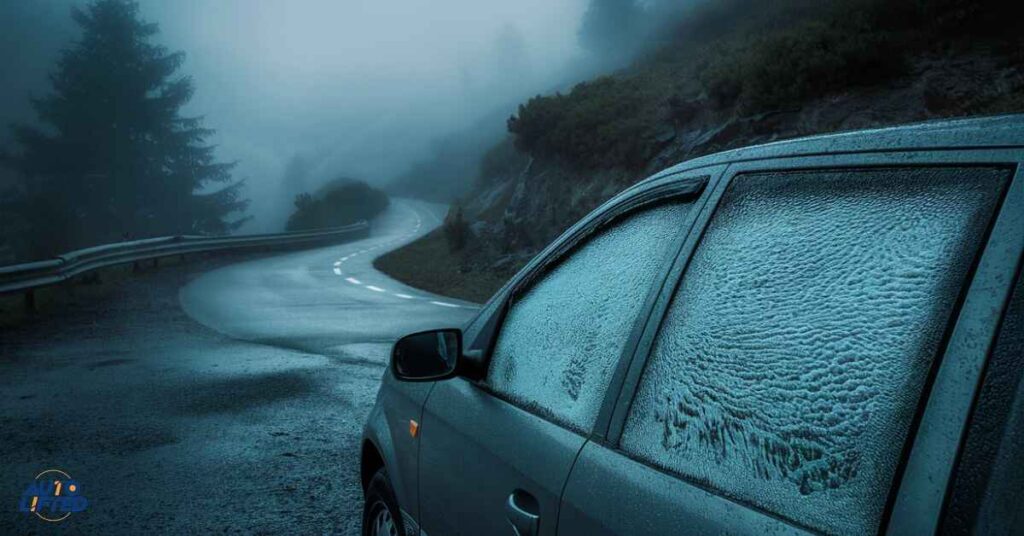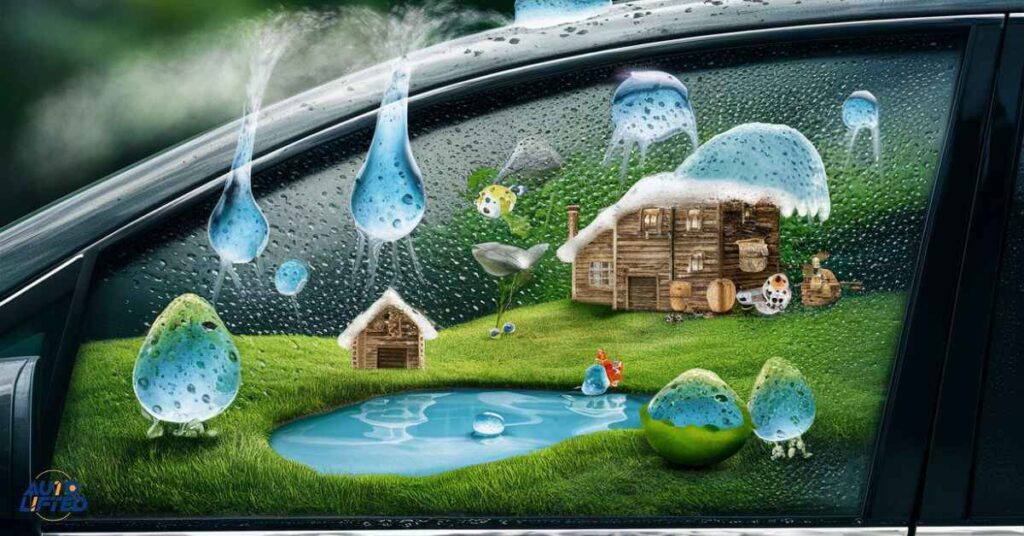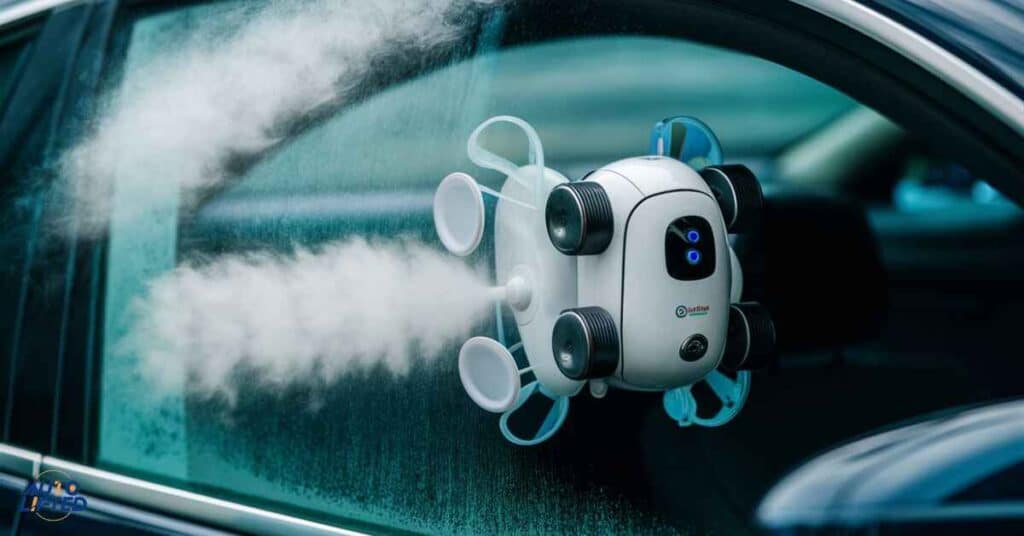Imagine this: you’re in the throes of passion with your significant other, fogging up the car windows with your hot and heavy makeout session.
But have you ever stopped to wonder why those windows get so foggy in the first place? Don’t worry, there’s a fascinating scientific explanation behind this romantic phenomenon!
The Science Behind Foggy Car Windows
The primary reason car windows fog up is due to a process called condensation. When warm, moist air comes into contact with a cooler surface, he water vapor in the air condenses into tiny liquid droplets, forming a foggy layer on that surface. It’s similar to how a cold glass “sweats” on a hot summer day.
The key factors enabling this condensation are the temperature differences between the air inside your steamy car and the glass windows, combined with the high moisture content of that interior air.
As you and your partner breathe heavily during your passionate make-out session, you’re increasing the warmth and humidity levels inside the enclosed vehicle. Meanwhile, the windows remain cooler from exposure to the outside air temperature.
This stark contrast causes the moisture in your breath to quickly condense on the colder glass surfaces, resulting in those telltale foggy windows.
To understand this better, let’s dive deeper into the science of condensation. When water vapor (gaseous form of water) comes into contact with a surface cooler than the dew point temperature, it undergoes a phase change from gas to liquid.
The dew point is the temperature at which the air becomes saturated with water vapor and can no longer “hold” the moisture, causing it to condense.
In the case of a steamy car during a make-out session, the combined factors of body heat, heavy breathing, and enclosed space raise the interior temperature and moisture levels. As this warm, humid air meets the cooler window glass, it exceeds the dew point, causing the water vapor to condense and form those tiny droplets we see as fog.
Read This Blog:
What Happens If A Leased Car Is Totaled?
Our Breathing is the Culprit

While body heat and other moisture sources contribute, our own breathing is the biggest culprit behind fogged-up car windows during a make-out session. With every exhale, we release warm water vapor directly onto the cooler glass surface of the windows surrounding us.
Think about it – when you breathe out on a cold day, you can see your breath appearing as condensation in the air. That’s because the warm, moist air from your lungs is meeting the cooler outside air, causing the water vapor to condense into visible droplets.
The same principle applies inside your car, except the cool surface attracting that condensation is the glass windows instead of open air.
The more people inside the car, the more sources of breath are adding humidity to the air. So you can imagine how rapidly the windows fog up when two (or more!) people are heavily breathing and generating body heat in such a small, enclosed space.
If you’ve ever noticed your windows remaining clear when driving alone versus immediately fogging when your partner joins you, that’s the power of shared breathing at work!
To illustrate with an example, let’s say the interior of your car reaches 75°F (24°C) during an intense make-out session, while the outside temperature is a crisp 40°F (4°C).
At those temperature differentials, with two people continuously exhaling warm, moist air inside the cabin, it doesn’t take long for the dew point to be reached and condensation to occur on those 40°F window surfaces.
Weather Conditions That Exacerbate Foggy Windows

Certain environmental factors can further exacerbate the window fogging effect when making out in a car:
- Cold outside air hitting the warmer car interior increases the temperature differential
- High humidity days mean there’s already more moisture in the air before you two start breathing heavily
- Rain or snow brings additional moisture into the car when you get inside with wet clothes or shoes
Any of these conditions essentially “pre-load” the car with moisture, requiring less of your breath to reach critical condensation levels on the glass.
For example, if it’s a hot, humid summer day at 90°F (32°C) with 70% relative humidity outside, that moist air enters your car before you even get steamy. With the combined moisture from your breathing and that already humid air, it becomes much easier to quickly reach condensation levels on the glass.
Similarly, if you hop in the car drenched from rain or wearing snowy clothes, the excess moisture from those wet fabrics immediately raises the humidity inside the enclosed cabin space.
Other Moisture Sources Playing a Role

While heavy breathing is the main instigator, there are several other sources of moisture inside a car that can contribute to window fogging, especially during make-out sessions:
- Wet clothes or shoes from rain/snow
- Spilled drinks leaving moisture on surfaces
- Sweating from increased body heat and energy expenditure
The enclosed space of a car’s interior traps this excess moisture instead of allowing it to dissipate. With all these contributors mixed together, it’s no wonder romantic car rendezvous so often leave windows resembling a steam room!
Let’s look at an example scenario: You and your partner meet up for a spontaneous make-out after getting caught in a rainstorm. You’re both wearing damp clothes as you eagerly hop into the car.
There may already be some water droplets on the seats or floor mats from your wet shoes. As you start making out heavily, the breathing condensation combines with that ambient moisture to exponentially fog up the enclosed space.
Even something as small as an open beverage can up the ante. If there’s a water bottle or soda sitting in the cupholder, that bit of excess liquid exposed to the cabin air adds more humidity that can contribute to quicker window fogging once the heavy breathing begins.
Why Cars in the Movies Never Seem Foggy

If you’ve noticed that intimate car scenes in movies rarely show the windows completely fogged over, there are a few reasons behind that:
- Filmmakers often apply anti-fog solutions or crack the windows before filming those scenes to prevent condensation buildup.
- If the windows do get too foggy during filming, the crew may simply stop rolling until the fog clears.
- During editing, scenes with excessive window fogging can be cut or digitally altered to have clearer visibility.
So while movies make it look easy to preserve crystal clear car windows, even during steamy make-out sessions, a bit of behind-the-scenes work is usually involved! Let’s take a humorous look at a few examples from popular films where hilariously foggy windows gave away what the characters were up to…
In the classic 90s rom-com “Can’t Hardly Wait,” Amanda Beckett and Preston Meyers’ secret make-out is memorably interrupted when the car windows fog up completely, revealing their silhouettes to the entire high school party. And who could forget the iconic scene from “Titanic” when Rose and Jack get carried away steaming up the old-fashioned car windows? Though romantic on camera, you can bet those actors were struggling to breathe by the end of that take.
Also Read This Blog:
What Is Car Detailing Interior
Quick Preventative Tips to Stay Fog-Free
Of course, sometimes a foggy car window is the last thing you want, whether for romantic reasons or just trying to drive safely. Here are some quick tips to keep fog at bay:
- Use the defogger/AC – Most modern cars have built-in defogger functions that blast warm, dry air to clear condensation from the windows. The air conditioning can also help regulate temperature and remove moisture from the cabin.
- Crack a window – Allowing some airflow by cracking open a window helps ventilate the moist air and prevent condensation buildup.
- Apply shaving cream to windows – Shaving cream leaves a thin barrier film that prevents fogging. Just wipe it on and off before/after your make-out!
- Bring desiccants into the car – Items like silica gel packs can absorb excess moisture from the air.
For more details on executing each of these preventative measures effectively, [check out this linked guide].
Using your car’s defogger is the fastest and most effective way to clear foggy windows. Most vehicles have a dedicated defogger button that turns on a powerful flow of heated air directed at the windows. The warm air helps evaporate the condensation while also lowering the overall humidity inside.
You can use the regular air conditioning as a supplementary measure. The A/C removes moisture from the cabin air, preventing it from re-condensing on the windows once cleared by the defogger. Just be sure to turn off the recirculation setting so it can bring in drier outside air.
The window cracking technique is a simple way to allow humid interior air to escape while drier outside air circulates in. This equalization helps remove the warm, moist air that was condensing on the glass. Just be cautious that wind doesn’t blow any rain or snow inside while your window is cracked.
For a makeshift anti-fog solution, shaving cream can work in a pinch. The creamy barrier it leaves on the glass prevents the warm interior air from directly condensing. Simply wipe a thin layer onto your foggy windows using a paper towel or cloth, then wipe it off before driving for clear visibility.
You can also try bringing some moisture-absorbing desiccants like silica gel packs into the car with you. Placing these near the windows helps remove humidity from the air to prevent condensation forming in the first place.
If you have access to a dehumidifier device, running it in your car for a bit before make-out sessions can significantly reduce the overall moisture levels that enable fogging. Just be sure it’s designed for smaller enclosed spaces like a vehicle interior.
More Permanent Solutions

While the quick tips above offer on-the-fly ways to clear foggy windows, there are also more permanent solutions you can look into, especially for frequent foggers:
- Replace worn window seals – Cracked or hardened window/door seals allow outside moisture in, which then condenses inside. Replacing them keeps that moist air out.
- Use anti-fog window treatments – Chemical treatments create a hydrophobic coating that causes moisture to bead off windows instead of condensing into fog.
- Upgrade old cabin air filters – Dirty, clogged filters make your A/C system less effective at dehumidifying the cabin air.
- Apply window tint – While not a permanent fix, window tint films help insulate glass to minimize temperature differences that enable fogging.
For long-term prevention, replacing any brittle window seals is key. As rubber seals around doors and windows age and harden over time, gaps form that allow outside moisture infiltration. This raises interior humidity levels even before make-out sessions start. Installing fresh, pliant seals closes those entry points.
There are also specialized anti-fog coatings and wipes designed to make your window glass resistant to fogging up in the first place. The transparent hydrophobic coating causes any condensation to form into easily removable water beads rather than an obscuring fog.
If your car’s A/C and defrost systems seem weak, the cabin air filter may need replacing. A fresh air filter allows proper airflow for effective dehumidification and defrosting of your windows when needed.
On the insulation front, ceramic window tint films can help reduce interior window temperatures being vastly different from the cabin air that fogs them up. The tint blocks some conductive heat transfer through the glass.
When to Be Careful With Remedies

While there are many handy tips for defog proofing your car windows, there are also some important safety precautions to keep in mind:
- Avoid harsh chemicals or abrasives – Products with ingredients like ammonia can permanently damage or cloud auto glass
- Be cautious with home remedies like vinegar – Some DIY solutions can lead to corrosion or foul odors if overused
- Only apply window films properly – Bubbles or peeling in tint films creates new surfaces for fogging
Certain household products like ammonia-based glass cleaners should never be used on your car windows, as these chemicals can permanently etch and damage the auto glass. Stick to dedicated auto glass cleaners and protectants.
While a vinegar and water solution can serve as a quick defogging agent, using it excessively may eventually lead to corrosion on your window frames and trim. And that same vinegar smell probably won’t help set the romantic mood during make-out sessions!
If opting for window tinting films, always have them professionally installed to avoid leaving any bubbles or peeled edges where condensation could collect. An improper DIY tint job essentially creates more surfaces for fogging.
The Foggy Make-Out Silver Lining
While much of this guide explores ways to prevent and remove foggy car windows, let’s not forget – a little atmospheric fog can sometimes contribute to the thrill of a steamy make-out session!
Many of us have nostalgic memories from younger years of passionate parking lot embraces that left every window completely opaqued with condensation. There was an undeniable sense of exhilaration and rebellion that came with those heavily fogged windows advertising just what kind of activities were happening inside.
As long as your visibility isn’t so obstructed that it creates actual driving hazards, a bit of window fogging can serve as flirtatious foreplay – a visible manifestation of the heated passion you’re sharing with your partner. Those translucent silhouettes and blurred forms seen through the haze can be incredibly sensual and intimate.
So while having the ability to quickly de-fog is important for safety reasons, don’t feel the need to blast those defoggers instantly at the first hint of condensation. Lean into the atmospheric romance periodically by leaving a hint of fog clinging to your windows. It can make your already steamy encounter feel even hotter!
Just be sure to clear your view fully before actually driving anywhere. Getting caught by law enforcement motoring around fully blind behind fogged windows would put quite the damper on date night.
Frequently Asked Question
Why do car windows fog up around me?
Car windows fog up around you because your body releases warm, moist air through breathing and sweating, which condenses on the cooler glass surfaces.
How to fog car windows for privacy?
To fog car windows for privacy, breathe heavily onto the interior surface or use a hot beverage close to the window to create steam, which causes condensation.
Why do cars get steamy when?
Cars get steamy when warm, moist air inside the vehicle meets the cooler glass surfaces, leading to condensation and fogging.
What does “fog up the windows” mean?
Fog up the windows, means the formation of condensation on the inside surfaces of car windows, caused by warm, moist air coming into contact with cooler glass.
How to avoid fog on windshield?
To avoid fog on the windshield, use the car’s defogger, turn on the air conditioning, and ensure proper ventilation to reduce humidity inside the car.
How to reduce fog in a car?
Reduce fog in a car by keeping the windows clean, using anti-fog treatments, maintaining good ventilation, and controlling the interior temperature to minimize moisture buildup.
Conclusion
The next time you find yourself fogging up the car windows with a heavily breathed make-out session, you can thank the scientific principles of condensation, temperature differences between the car’s cabin and windows, and the abundance of water vapor from your mutual breathing.
While a foggy car window is an easy giveaway of your romantic antics, there are preventative measures like running the defogger, cracking a window, or using a de-fogging treatment that can help maintain clear visibility when needed. More permanent solutions include replacing worn window seals, applying hydrophobic coatings, and upgrading cabin air filters.
However, don’t be too hasty to fully de-fog every time. A little window condensation can add to the thrill, intimacy and overall steaminess of your car rendezvous when not taken to hazardous extremes. Feel free to periodically let that romantic fog linger a bit before shedding the haze.
At the end of the day, a foggy car window is simply the atmospheric byproduct of the passion and body heat being generated during your romantic make-out session. As long as you keep safety in mind, that window condensation can serve as a steamy memento of your intimate embraces behind the wheel.
